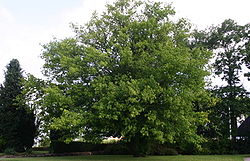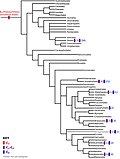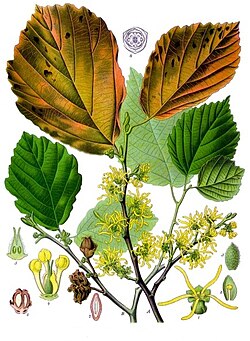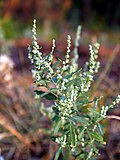The APG II system (Angiosperm Phylogeny Group II system) of plant classification is the second, now obsolete, version of a modern, mostly molecular-based...
7 KB (651 words) - 08:44, 20 October 2024
was replaced by the improved APG II in 2003, APG III system in 2009 and APG IV system in 2016. The original APG system is unusual in being based, not...
20 KB (1,430 words) - 08:37, 21 June 2025
The APG III system of flowering plant classification is the third version of a modern, mostly molecular-based, system of plant taxonomy being developed...
47 KB (3,194 words) - 23:22, 30 November 2024
which the family was named. In 2003, the formation of the APG II plant classification system radically expanded the Asparagaceae to include the genera...
28 KB (1,370 words) - 02:11, 18 July 2025
The APG IV system of flowering plant classification is the fourth version of a modern, mostly molecular-based, system of plant taxonomy for flowering...
40 KB (2,558 words) - 15:23, 27 July 2025
Tiliaceae (section APG II system)
(/ˌtɪliˈeɪsii/) is a family of flowering plants. It is not a part of the APG, APG II and APG III classifications, being sunk in Malvaceae mostly as the subfamilies...
7 KB (751 words) - 00:33, 5 January 2024
Liliopsida (section Liliopsida in the Takhtajan system)
name Liliidae (a name in the rank of subclass). Modern systems, such as the APG and APG II systems refer to this group by the name monocots (a name for...
7 KB (679 words) - 08:41, 21 June 2025
The AN/APG-85 is an active electronically scanned array (AESA) radar system designed by Northrop Grumman for the Lockheed Martin F-35 Lightning II. The...
2 KB (269 words) - 01:54, 1 June 2025
Simaroubaceae The APG II system of 2003 allowed the optional segregation of families now included in the Nitrariaceae. In the classification system of Dahlgren...
5 KB (407 words) - 02:32, 13 November 2024
Angiosperm Phylogeny Group when they published the APG II system in 2003. In the Cronquist system, there is no Aquifoliales order: the Aquifoliaceae are...
3 KB (265 words) - 12:03, 20 June 2025
flowering plants, included within the asterid group of dicotyledons. In the APG III system of 2009, the order includes only two families, Adoxaceae and a broadly...
3 KB (263 words) - 04:40, 8 April 2024
Liliidae (section Liliidae in APG II system)
In the Dahlgren system and the Thorne system (1992) this is an important name: this subclass comprises the monocotyledons (in APG II these are the monocots)...
3 KB (245 words) - 21:37, 17 June 2022
of the family is the yam (some species of Dioscorea). The APG system (1998) and APG II system (2003) both place it in the order Dioscoreales, in the clade...
7 KB (482 words) - 04:52, 8 April 2024
flowering plants. The name is newly accepted in the APG III system of plant taxonomy. APG II system, of 2003, mentions the possibility of recognizing the...
2 KB (198 words) - 11:59, 20 June 2025
Orchidales (section APG system)
Orchidales family Orchidaceae Wettstein system order Gynandrae family Orchideae The order is not recognized in the APG II system, which assigns the orchids to order...
3 KB (255 words) - 19:40, 26 May 2025
revisions have been published, in 2003 (APG II), in 2009 (APG III) and in 2016 (APG IV), each superseding the previous system. Thirteen researchers have been...
33 KB (3,554 words) - 08:36, 21 June 2025
influential recent classification systems, such as the Cronquist system, the Thorne system, the Takhtajan system or the APG II system. Okuyama, Yudai; Kato, Makoto...
2 KB (222 words) - 23:25, 27 May 2025
potentially containing one family, Dilleniaceae. The APG III system of 2009, like the earlier APG II system of 2003, left the Dilleniaceae unplaced as to order...
2 KB (168 words) - 20:11, 4 February 2025
Arecidae (section APG II system)
Pandanaceae order Arales family Acoraceae family Araceae family Lemnaceae The APG II system does not use formal botanical names above the rank of order; it assigns...
2 KB (180 words) - 18:02, 29 March 2021
Alismatidae (section APG II system)
these are aquatic or semiaquatic plants (see Alismatidae info). The APG II system does not use formal botanical names above the rank of order; it assigns...
2 KB (195 words) - 01:33, 23 December 2022
plant taxonomy. In the APG II system (2003) the plants involved are mostly placed in the order Malpighiales. A well known system that did recognize the...
1 KB (124 words) - 17:37, 5 December 2022
Plant taxonomy (section Classification systems)
recent research were published as the APG II system in 2003, the APG III system in 2009, and the APG IV system in 2016. Traditionally, the flowering plants...
15 KB (1,685 words) - 14:28, 16 July 2025
circumscribed by APG II-system, the order includes about 6000 species within nine families. The order is placed in the eurosids II, which are part of...
9 KB (905 words) - 21:23, 27 March 2025
suggested that these families are not closely related to each other. The APG II system (2003) assigns them to several different orders: Hamamelidaceae and...
3 KB (313 words) - 21:24, 16 June 2024
Westinghouse Electronic Systems) for the Lockheed Martin F-35 Lightning II. The AN/APG-81 is a successor radar to the F-22's AN/APG-77, and has an antenna...
8 KB (784 words) - 01:20, 1 June 2025
the family Amaranthaceae in the APG II system; older classification systems, notably the widely used Cronquist system, separate it and its relatives as...
26 KB (2,403 words) - 00:14, 26 July 2025
The APG II system, used here, includes all the plants involved in the (expanded) order Brassicales. Cronquist, Arthur (1981). An Integrated System of Classification...
1 KB (127 words) - 21:01, 6 November 2024
Zingiberidae (section APG II system)
needed] subclass Zingiberidae order Zingiberales order Bromeliales The APG II system does not use formal botanical names above the rank of order. The plants...
1 KB (136 words) - 17:15, 30 June 2025
Rhoipteleaceae, the latter consisting of only a single species. In the APG II system these two families are united into family Juglandaceae (with the split...
1 KB (116 words) - 18:25, 25 November 2023
"lizard's-tail family". The APG IV system (2016; unchanged from the 2009 APG III system, the 2003 APG II system and the 1998 APG system) assigned it to the order...
4 KB (333 words) - 03:22, 8 April 2024






















